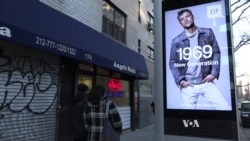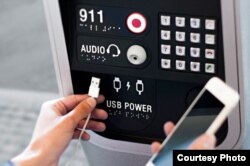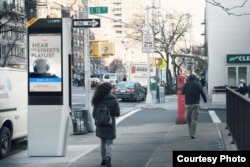Phone booth, meet your great-great-grandchildren.
Futuristic, 3-meter-tall Wi-Fi portals are steadily moving into New York, replacing thousands of old payphones while using their existing infrastructure. By summer’s end, more than 500 units will dot the city; in 12 years, there will be as many as 10,000.
The selling points are simple: They are free to use — featuring hotspot 2.0 encryption technology (i.e., a more secure connection) and thereby providing gigabit-speed Internet to the city’s 8.5 million residents. That’s roughly 100 times faster than average public Wi-Fi and five times faster than the capability of most smartphones.
“It means you can upload pictures in a fraction of a second, you can download a movie before you hop on the train in less than 30 seconds, you can have the content that you want downloaded to your phone and be able to use that on your journey throughout the day in the city,” said Jen Hensley, general manager of LinkNYC, the communications network tasked with bringing the units to the city’s sidewalks.
The Links, which have already launched in beta phase, each feature two flashy 140-centimeter HD digital screens for public service announcements and advertising, LinkNYC’s primary source of revenue.
Bridging the technology divide
The high-speed Wi-Fi reaches a minimum radius of 45 meters before automatically connecting to the next available Link. Every unit is equipped with a charging device and Android tablet for Internet browsing, phone calls and easy access to information on city services, as well as a 911 emergency call button.
Hensley said the idea is to reach all New Yorkers who might not otherwise have access to a broadband connection, either in their homes or at work.
“We look forward to being able to provide the opportunity for educational, professional and recreational access that really every human deserves in this day and age,” Hensley said.
The unit’s infrastructure is built using a cast aluminum exterior, designed by CIVIQ Smartscapes to withstand vandalism and severe weather, including flooding, earthquakes, extreme heat and cold.
Joshua Berglund, engineering program manager at CIVIQ Smartscapes, said its designers have extensive experience in military application manufacturing, which was useful in developing LinkNYC’s “rugged” structure.
He said the key structural feature of New York’s Links is their ability to blend in with their surroundings, representing “a natural progression of the city.”
“It stands out on its own, but it doesn’t really jump out at you and stand out too much from the rest of the streetscape,” Berglund said.
Global model
LinkNYC expects CityBridge, the consortium awarded the 12-year franchise, to generate more than $500 million for the city of New York over the span of its contract, while regaining its capital investment worth $200 million.
It’s a venture that Hensley describes as a “revolutionary” model for cities worldwide who want to deliver quality services to their residents and visitors.
“It's a global economy," she said. "People are traveling more and more, and the services that they know they can rely on in New York, we expect them to want when they go to places like London and Paris and Hong Kong.”
In addition to its current features, LinkNYC plans to roll out additional apps and services over the next few months. The company expects to install 4,500 Links within the first four years, across all five New York boroughs.











